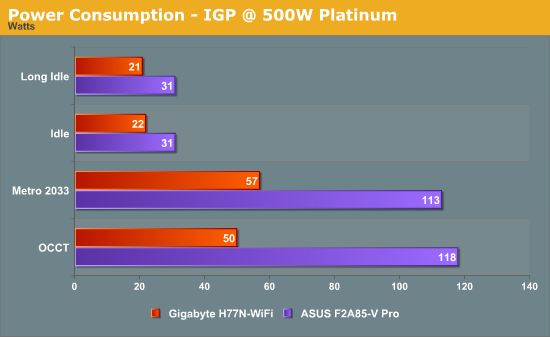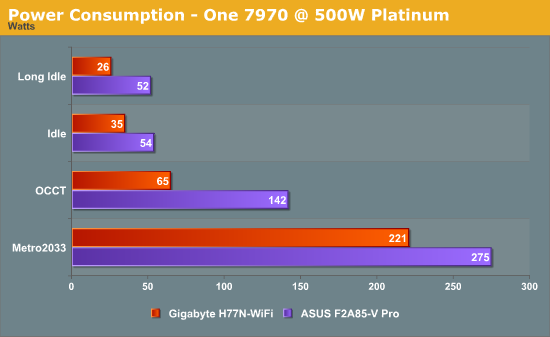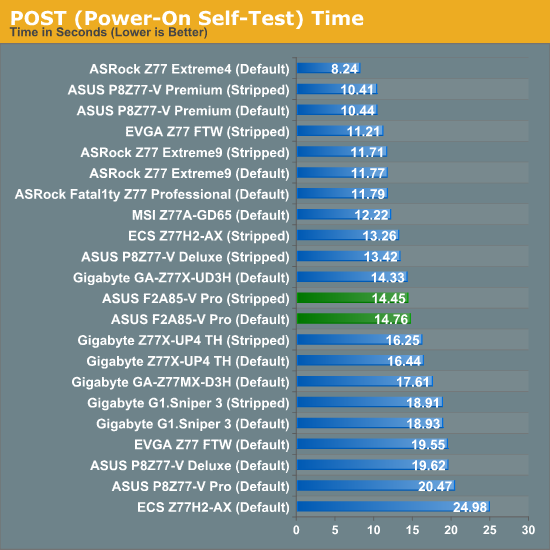ASUS F2A85-V Pro Review: A Look at FM2 with A85X
by Ian Cutress on October 10, 2012 11:20 AM EST- Posted in
- Motherboards
- Asus
- Trinity
- FM2
- A85X
Many thanks to...
We must thank the following companies for kindly donating hardware for our test bed:
OCZ for donating the Power Supply and USB testing SSD
Micron for donating our SATA testing SSD
G.Skill for donating our memory kits
ASUS for donating AMD GPUs and some IO testing kit
ECS for donating NVIDIA GPUs
Gigabyte for donating the i3-3225 used for comparison
Comparison of AMD Processors
On the following benchmarks, we will use results from comparible tests with previous processor families over the past 18 months. For AMD, this means we can compare the new Piledriver modules to Llano with its Stars cores, Phenom II and Thuban, and Zambezi with Bulldozer. The following processors are ones we have a variety of results for:
A6-3650 (32nm, 2.6 GHz) – Llano, 4 Stars cores
A8-3850 (32nm, 2.9 GHz) – Llano, 4 Stars cores
X6 1100T (45nm, 3.7 GHz Turbo) – Phenom II, 6 Thuban cores
FX-8150 (32nm, 4.2 GHz Turbo) – Zambezi, 4 Bulldozer modules
A10-5800K (32nm, 4.2GHz) – Trinity, 2 Piledriver modules
On the Intel side, we have the following:
Core i7-3960X (32nm, 3.9 GHz Turbo) – Sandy Bridge-E, 6 cores / 12 threads
Core i7-3770K (22nm, 3.9 GHz Turbo) – Ivy Bridge, 4 cores / 8 threads
Core i5-2500K (32nm, 3.7 GHz Turbo) – Sandy bridge, 4 cores / 4 threads
Core i3-3225 (22nm, 3.3 GHz) – Ivy Bridge, 2 cores / 4 threads
The aim of AMD is to put the A10 square on the bow of the Core i3-3225. For comparison, the A10-5800K release price is $122, whereas the boxed version of the i3-3225 should be ~$144.
Test Setup
| Processor |
AMD Trinity A10-4800K APU 2 Modules, 4 Threads, 3.8 GHz (4.2 GHz Turbo) |
| Motherboards | ASUS F2A85-V Pro |
| Cooling | beQuiet DarkPro CPU Cooler |
| Power Supply |
OCZ 1250W Gold ZX Series Rosewill SilentNight 500W Platinum PSU |
| Memory | G.Skill TridentX 4x4 GB DDR3-2400 10-12-12 Kit |
| Memory Settings | XMP |
| Video Cards |
ASUS HD7970 3GB ECS GTX 580 1536MB |
| Video Drivers |
Catalyst 12.3 NVIDIA Drivers 296.10 WHQL |
| Hard Drive | Corsair Force GT 60 GB (CSSD-F60GBGT-BK) |
| Optical Drive | LG GH22NS50 |
| Case | Open Test Bed - DimasTech V2.5 Easy |
| Operating System | Windows 7 64-bit |
| SATA Testing | Micron RealSSD C300 256GB |
| USB 2/3 Testing | OCZ Vertex 3 240GB with SATA->USB Adaptor |
Our main Intel comparison system is a to-be-reviewed Gigabyte H77N-WiFi with a 65W dual core i3-3225 processor against the 100W A10-5800K.
Power Consumption
Power consumption was tested on the system as a whole with a wall meter connected to a Rosewill 500W 80PLUS Platinum SilentNight power supply. As I am in the UK on a 230-240 V supply this leads to ~75% efficiency at low loads, and 90%+ efficiency between 20% and 100% loading. This method of power reading allows us to compare the power management of the UEFI and the board to supply components with power under load, and includes typical PSU losses due to efficiency. These are the real world values that consumers may expect from a typical system (minus the monitor) using this motherboard.


From our internal results, testing with 1 GPU on the 500W Platinum and 1250W Gold gave similar power readouts (Idle/OCCT/Metro on 500W gave 54/142/275, on 1250W gave 59/148/280), which means the 1250W is still good for comparison on the system. However for IGP testing, it was important to use the 500W. Our main comparison is the i3-3225 dual core Intel system on the to-be-reviewed Gigabyte H77N-WiFi, though the wattage between the processors accounts for large differences under load. At idle the larger ATX F2A85-V Pro does consume more power – if we get an ITX FM2 system, this will be a better comparison to test.
POST Time
Different motherboards have different POST sequences before an operating system is initialized. A lot of this is dependent on the board itself, and POST boot time is determined by the controllers on board (and the sequence of how those extras are organized). As part of our testing, we are now going to look at the POST Boot Time - this is the time from pressing the ON button on the computer to when Windows starts loading. (We discount Windows loading as it is highly variable given Windows specific features.) These results are subject to human error, so please allow +/- 1 second in these results.

The F2A85-V Pro uses ASUS’ new CAP BIOS system, designed to aid in POST times across their motherboard range. It helps a little here, as normally for ATX boards POST times are in the 16+ second region – the CAP BIOS reduces this to just under 15 seconds.










66 Comments
View All Comments
zappb - Sunday, November 4, 2012 - link
I just build 3 of these office machines (prices in euros before VAT / sales tax)AMD A6-5400K - 50
Asrock FM2A75M - DGS - 45
Fractal Core 1000 - 30
Intel 330 120 GB ssd - 75
Mushkin 4GB ddr3 -1600- 13
Be quiet pure power L7 300w - 32
Win8 pro oem (w/Start8)a 110
Office 2010 pro 100
Hardware comes to €245, and if I could have sourced the A4-5300, would have knocked another 15 off that. Amd will be pricing the entry level FM2 stuff really agressively in Jan 2013 onwards, so you could probably pick up the A4-5300 for 30 euro.
,
WEI scores are: Processor: 6.3, Memory: 5.9, Graphics: 4.7, Gaming Graphics: 6.3, primary hard disk, 8.1.
Will test power consumption shortly, but just seeing the load on the CPU with excel, word, and chrome with 5 browser windows open, it hovers around 1- 4%, so meaning for these light usage cases, it might be cheaper to run than the intel options (that would be a real turn up for the books).
crimson117 - Wednesday, October 10, 2012 - link
I'm having trouble parsing this sentence...> From my perspective, a storage system the RAID 5 that the A85X chipset supports across the eight SATA 6 Gbps ports is golden where Trinity is concerned.
KineticHummus - Thursday, October 11, 2012 - link
it means using trinity in a storage system/home server is great because it natively supports raid 5 across all 8 sata3 ports, which intel can not do.Anonymous Blowhard - Thursday, October 11, 2012 - link
Except that anyone running an 8-drive RAID5 with large, slow, consumer off the shelf SATA drives is either uninformed or a moron.Odds on getting an unrecoverable read error with large (1TB+) drives during a RAID5 rebuild are incredibly high; that's why enterprise SANs are using things like 450GB/600GB SAS drives now, and those have a failure rate an order of magnitude lower than consumer grade SATA.
Home servers should be using RAID1, 10, Z, Z2 - or just none at all. Whatever you use, doing proper backups (which RAID is not) is critical if you care about your data. DVDs I've ripped? I can get those again. Pictures of my son's first birthday? Backed up in triplicate, multiple offsite, and cloud stored.
http://www.zdnet.com/blog/storage/why-raid-5-stops...
ven1ger - Thursday, October 11, 2012 - link
First of if you're calling someone a moron, maybe you should look in the mirror.The article that you linked was written back in 2007, and if you read some of the comments, many of the comments thought it was much ado about nothing.
Maybe you should check out what current cloud based backup companies look like, here's an example that I was just reading about a couple of days ago.
http://blog.backblaze.com/
Very interesting story, commercial cloud based storage company that uses consumer SATA drives. They even have open-sourced hardware design(s) available for their PODs that anyone can use to create their own muti-drive backup system, and which several others have created, if you are so inclined that way.
I am no way involved with Backblaze, just was an interesting story piece that I ran across and their tale of harvesting consumer grade 3TB SATA drives in the aftermath of the Thailand flooding.
Anonymous Blowhard - Thursday, October 11, 2012 - link
Ad hominem ignored.The article was correct then and even more now. As data density has increased, reliability has not kept pace.
Using BackBlaze, or most any "cloud backup provider" as a reference for pro-RAID-5 is a bad idea. Cloud storage providers create their redundancy at the system level. Reliability, availability, and operational efficiencies are all hugely increased by treating the entire system as an FRU. It's cheaper for them to just wait for there to be enough downed pods to justify "Okay, let's roll into the DC, pull out a dozen systems, and slap in new ones." They don't have the time or concern to troubleshoot individual drive failures.
(Also, BackBlaze uses RAID-6.)
So again, if you're using RAID-5 with big, slow, error-prone drives; please stop doing that if you care about your data.
Memristor - Wednesday, October 10, 2012 - link
What version of the AHCI, RAID and USB 3.0 BIOS is on this new board? It would be very helpful if you could include the version of these BIOS's in your board reviews. Since it is very easy to updated the firmware of these components outside of a regular motherboard BIOS update it can be very helpful to increase performance and other issues that arise especially with RAID configurations and newer SSD drives.djshortsleeve - Wednesday, October 10, 2012 - link
Ian, glad you mentioned hysteresis. I dont understand why they dont incorporate this control? Its fairly simple as long as a target temperature is defined.goinginstyle - Wednesday, October 10, 2012 - link
"This could be an error on the part of OCCT.." If you do not know what the problem is then why mention it in the review as a performance concern. Either OCCT is updated to work with Trinity or more than likely it is not but find out before you state it. As to DPC latency, is it really a EFI problem or a platform problem as Llano is not much better.Hardcore69 - Wednesday, October 10, 2012 - link
Why bother? An Ivy Bridge i3 is 55w and is close to the equivalent except for the GPU, less than a fart's difference CPU wise. Compared to a hot 100w CPU, if you don't game, this isn't worth bothering with. At all for a standard office box. As for the mobo, I'd prefer a gruntier CPU than fancy useless heatpipes.